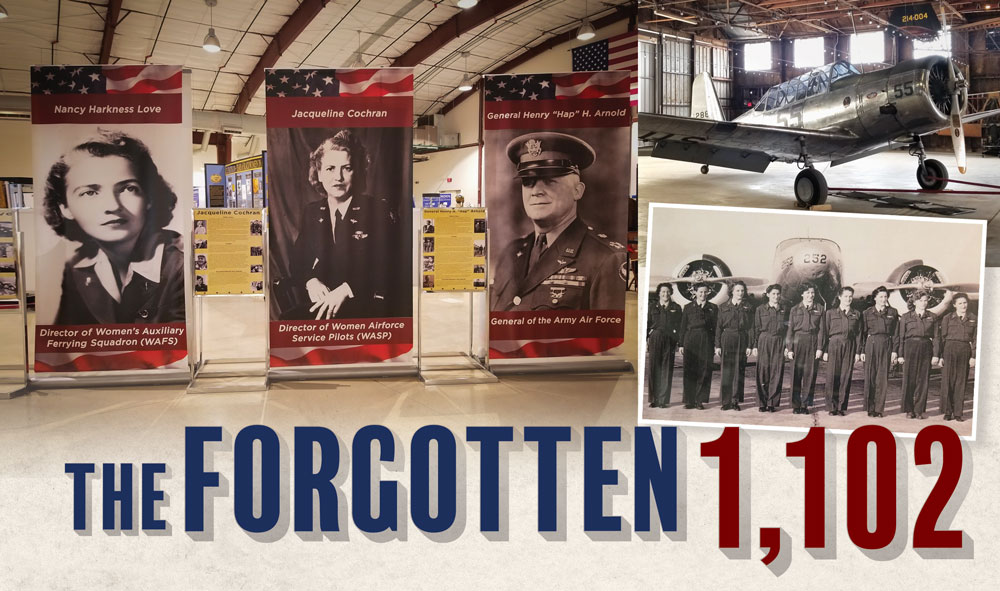
Following Amelia Earhart’s famous transatlantic flight in 1932, American women grew interested in aviation. In 1929, Ninety-Nines, a group open to all female pilots, formed. From 117 invitations, 99 ladies became charter members. With rumblings of WWII, these women wondered how to help. The attack on Pearl Harbor on December 7, 1941, drove deep desires of flying against the enemy. Unfortunately, at the time, the U.S. military didn’t accept women pilots.
One Ninety-Nines member, Nancy Love, earned her pilot’s license at 16. Earning a degree from Vassar College, she worked as a pilot for a company her husband started. Knowing many opportunities for pilots outside combat existed, she believed women could handle those jobs. In early 1940, Nancy wrote to the Army Air Force. The men in charge, including General Hap Arnold, declared they needed more planes, not more pilots.
Jacqueline (Jackie) Cochran, one of the most accomplished pilots of her era, also insisted women pilots could free men to join combat. Writing letters in 1939, she also met rejection.
Late in 1942, with heavy war casualties, General Arnold finally agreed. They needed women to ferry aircraft in the U.S. Nancy Love headed up a squadron that included Betty Gillies, Cornelia Fort and others from the Ninety-Nines. On September 5, 1942, after qualifying for the program, the ladies became WAFS —Women’s Auxiliary Ferrying Squadron.
Jackie returned to America from England a few months later. While she believed in women pilots’ capability, her plan included training more women. With Hap Arnold’s approval, she headed the Women’s Flying Training Detachment in Houston, Texas. Over 25,000 women applied, but only 1,074 women successfully completed the program, and joined WAFS countrywide.
The Houston facilities, down the road from Ellington Field where combat pilots trained, had no barracks or dining facilities for women. Early in 1943, under Jackie’s leadership, WAFS and WFTD joined forces as Women’s Airforce Service Pilots. Of the 1,102 WASP, 38 died during service.
The training center moved to Avenger Field in Sweetwater, Texas, where a museum remembering the WASP remains today. They adopted Fifi as mascot, referring to Fifinella, the imaginary female gremlin who supposedly caused crashes. In summer, without air conditioning, they slept outside sometimes. More than once, women woke up with scorpions or rattlesnakes as bedmates.
Although the women experienced the same grueling training as military pilots, Nancy and Jackie agreed to keep the WASP civilian to get the programs moving. Denied benefits of male pilots, they covered personal costs for food, lodging and transportation much of the time. Many combat pilots admired and respected these women.
Some, like Betty, had special blocks made to reach aircraft pedals. They used pillows to increase their height. While combat pilots generally trained on one aircraft, the WASP learned to fly multiple planes.
Initially ferrying only small aircraft, the women gained experience and took on challenges of flying bombers. They accepted any job that supported winning the war. Besides ferrying planes, WASP flew missions some men didn’t dare accept. When a plane got a dangerous reputation, a WASP flew flight demonstrations, encouraging men to accept the risk.
For training, WASP flew planes with live rounds of ammunition aimed at their trailing banner, often landing a plane riddled with bullet holes. They flew by instrument only while avoiding searchlights. They towed gliders for combat pilots learning to maneuver the silent aircraft that delivered supplies behind enemy lines.
Many WASP served as instructors for military pilots, provided air taxi service for military bigwigs and played the enemy during dogfight training. These women also served as maintenance test pilots, a job most veteran pilots, civilian and military, refused.
A handful flew in top-secret experiments, developing drones. The drones of WWII required a “mother ship” for direction. While beep pilots learned to control drones, WASP piloted the mother ship and two of them served as safety pilots on the drones.
Despite everything, in 1944, Congress refused to militarize WASP with full benefits, mostly because of misinformation. Disappointed, the women still wanted to serve, but in December 1944, the military ended
the program.
In their short lifespan, the WASP flew 60 million miles. Some joined the military in allowed roles, but many returned to civilian life. They didn’t receive benefits like other pilots who served in WWII.
Through continued efforts, the WASP finally received retroactive military status in 1977. In 2010, they received the Congressional Gold Medal. Only a handful remained alive by that time, but everyone agreed — they’d do it again without hesitation. The women known as WASP didn’t seek glory, fame or wealth. They simply wanted to use their gifts to defend against tyranny, and they allowed no one to stop them.
Editor’s Note: Visit www.waspmuseum.org to learn about the National WASP WWII Museum.
Photos by Lisa Bell with permission of the National WASP Museum.
Sources:
1. Caroline Johnson, A. I. (2018, August 5). Women with Wings: The 75-Year-Legacy of the WASP. Retrieved from National Space and Air Museum: https://airandspace.si.edu/stories/editorial/women-wings-75-year-legacy-wasp.
2. Pearson, P. O. (2018). Fly Girls. New York: Simon & Shuster Books for
Young Readers.
Written by Lisa Bell

You must be logged in to post a comment.